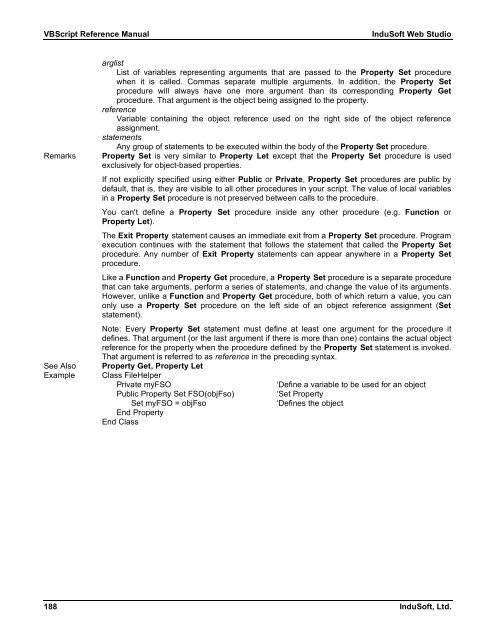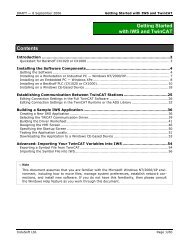VBScript Reference Manual for InduSoft Web Studio
VBScript Reference Manual for InduSoft Web Studio
VBScript Reference Manual for InduSoft Web Studio
You also want an ePaper? Increase the reach of your titles
YUMPU automatically turns print PDFs into web optimized ePapers that Google loves.
<strong>VBScript</strong> <strong>Reference</strong> <strong>Manual</strong> <strong>InduSoft</strong> <strong>Web</strong> <strong>Studio</strong><br />
arglist<br />
List of variables representing arguments that are passed to the Property Set procedure<br />
when it is called. Commas separate multiple arguments. In addition, the Property Set<br />
procedure will always have one more argument than its corresponding Property Get<br />
procedure. That argument is the object being assigned to the property.<br />
reference<br />
Variable containing the object reference used on the right side of the object reference<br />
assignment.<br />
statements<br />
Any group of statements to be executed within the body of the Property Set procedure.<br />
Remarks Property Set is very similar to Property Let except that the Property Set procedure is used<br />
exclusively <strong>for</strong> object-based properties.<br />
If not explicitly specified using either Public or Private, Property Set procedures are public by<br />
default, that is, they are visible to all other procedures in your script. The value of local variables<br />
in a Property Set procedure is not preserved between calls to the procedure.<br />
You can't define a Property Set procedure inside any other procedure (e.g. Function or<br />
Property Let).<br />
The Exit Property statement causes an immediate exit from a Property Set procedure. Program<br />
execution continues with the statement that follows the statement that called the Property Set<br />
procedure. Any number of Exit Property statements can appear anywhere in a Property Set<br />
procedure.<br />
Like a Function and Property Get procedure, a Property Set procedure is a separate procedure<br />
that can take arguments, per<strong>for</strong>m a series of statements, and change the value of its arguments.<br />
However, unlike a Function and Property Get procedure, both of which return a value, you can<br />
only use a Property Set procedure on the left side of an object reference assignment (Set<br />
statement).<br />
Note: Every Property Set statement must define at least one argument <strong>for</strong> the procedure it<br />
defines. That argument (or the last argument if there is more than one) contains the actual object<br />
reference <strong>for</strong> the property when the procedure defined by the Property Set statement is invoked.<br />
That argument is referred to as reference in the preceding syntax.<br />
See Also Property Get, Property Let<br />
Example Class FileHelper<br />
Private myFSO ‘Define a variable to be used <strong>for</strong> an object<br />
Public Property Set FSO(objFso) ‘Set Property<br />
Set myFSO = objFso ‘Defines the object<br />
End Property<br />
End Class<br />
188 <strong>InduSoft</strong>, Ltd.



